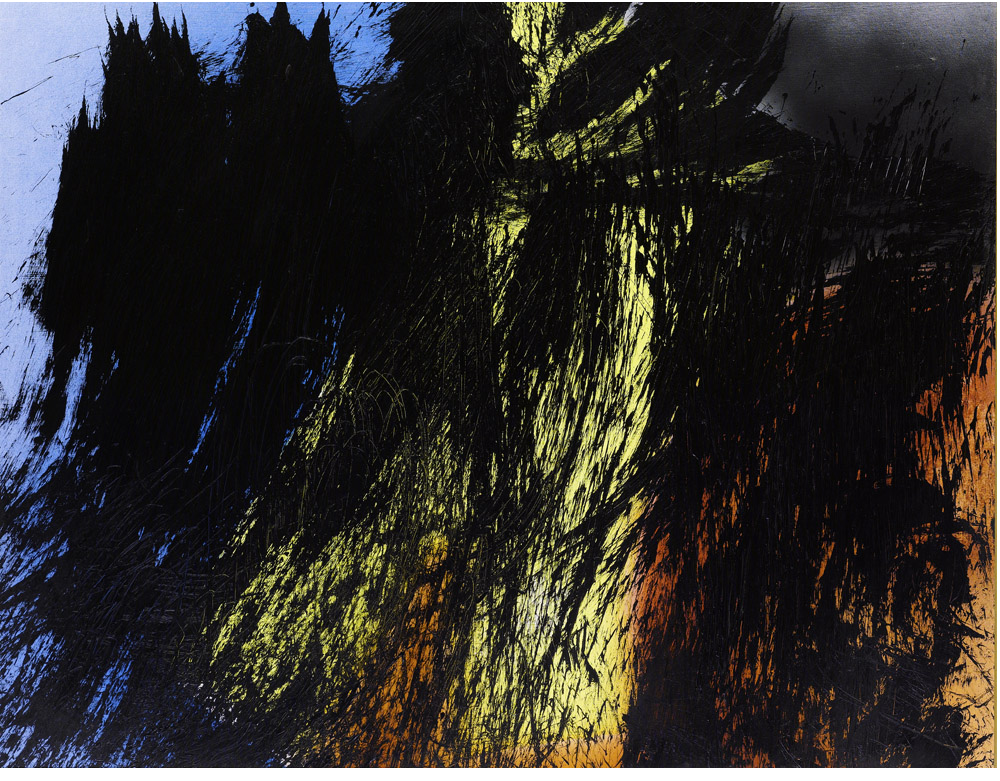Hans HartungT1979-E21
1979
Acrylic on board
Monogrammed and dated lower left
44.88 x 57.48 in ( 114 x 146 cm )ZoomInquiry - T1979-E21, 1979
Provenance
Collection Tonelli, Terni
Sothebys, Milan
Collection Privée, France
Artwork's description
Hans Hartung's T1979-E21, created in 1979, embodies the energy and experimentation of his Broom Period. This 114 x 146 cm canvas uses acrylics, a choice that allowed Hartung to work quickly and spontaneously. The artist uses a broom to draw sweeping, dynamic lines, adding gestural force to his painting.
Shades of blue, yellow and orange shine through the deep black, creating effects of superimposition and transparency. The gesture, both powerful and masterful, bears witness to the evolution of his practice, marked by the amputation of his leg at the end of the Second World War. This episode reinforced the intensity of his movements, visible in the vigor of his brushstrokes. The canvas, abstract and expressive, captures a raw energy, between violence and beauty.
The use of tools such as the broom adds a unique dimension to his art, flirting with the boundaries between painting and performance.
Artist's biography
Hans Hartung was born on September 21, 1904, in Leipzig, Germany. His grandfather, a doctor, amateur painter, and musician, played a significant role in his upbringing, infusing the household with a love for painting and music. From his childhood, Hartung developed an early passion for art. He began drawing in his school notebooks at a young age, influenced by the storms he found both terrifying and captivating. The Hartung family moved to Basel, Switzerland, from 1912 to 1914, where young Hans became fascinated with astronomy and photography. The outbreak of World War I forced the family to return to Leipzig in 1914. The experiences of war deeply affected the young artist, who adapted his art to these events, notably drawing the menacing zeppelins he saw in Dresden.
Hartung attended high school in Dresden until 1924. During this period, he began freely copying the works of the great masters of painting and discovered the German Expressionists, simplifying their compositions to retain only colored masses. By 1922, he painted a series of 33 already abstract watercolors, marking the beginning of his artistic exploration into abstraction. He continued his studies in philosophy and art history at the Academy of Fine Arts in Leipzig, where he attended a lecture by Kandinsky in 1925, thus marking his first oppositions to certain artistic concepts.
Hans Hartung moved to Paris in 1926, where he attended various academies but found little affinity with conventional teachings. He still preferred to copy the old masters at the Louvre and the moderns in art galleries. In 1928, he married the young Norwegian painter Anna-Eva Bergman. Hartung's first exhibitions in 1931 marked the beginning of his artistic recognition. However, the rise of National Socialism compelled him to leave Germany, and he settled permanently in Paris in 1935, where he actively opposed the Nazi regime.
In Paris, Hartung associated with many artists and regularly exhibited his works. However, the financial situation remained precarious, especially after his first wife suffered from a prolonged illness and he was stripped of his passport by the German embassy. During World War II, he joined the French Foreign Legion and was wounded in combat in 1944, losing a leg. After the war, he resumed his artistic work with vigor, dedicating himself to a darker and more introspective painting, reflecting his feelings of disillusionment and anguish.
In the years following the war, Hartung experienced increasing recognition. In 1947, a solo exhibition at the Galerie Lydia Conti truly revealed him to the public, where he met other influential artists. In the early 1950s, he began experimenting with new painting techniques, abandoning the grid for vinyl paints, allowing him greater spontaneity in creating his works.
The 1950s and 1960s marked a period of international recognition for Hartung. He participated in numerous exhibitions worldwide and saw his work displayed in prestigious galleries and museums. In 1960, he was awarded the Grand Prix de Peinture at the Venice Biennale, cementing his status as a major artist. In the following years, he continued to experiment with new techniques, and his work evolved towards clearer and more serene pieces. Despite health problems, Hartung continued to produce prolific work until his death in 1989. After his passing, his fame and influence endured, and several retrospectives were dedicated to him, thus ensuring his legacy in art history.
